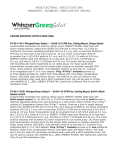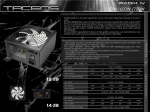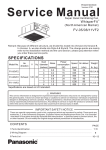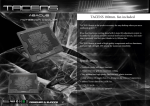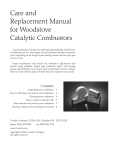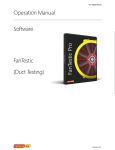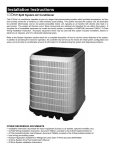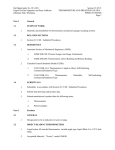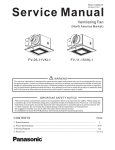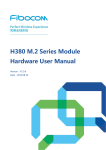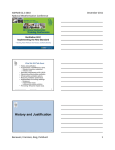Download implementation strategies for residential ventilation―Paul Francisco
Transcript
2/19/2015 Paul Francisco Indoor Climate Research & Training 1 ` Consensus standard is ASHRAE 62.2 (for residential) ` Has whole‐building and local exhaust requirements ` Has alternate path for existing buildings with insufficient local exhaust ` Often – but not always – met using exhaust fans 2 ` 62.2 does NOT require exhaust; there may be times when you want something else ◦ Combustion safety concern x Though it is rarely the 62.2 fan that is the big issue ◦ Humidity concern x Typically caused by non‐porous materials like vinyl wallpaper ` When exhaust seems like a bad idea, consider supply or balanced 3 1 2/19/2015 ` Use existing fans ◦ If they are working ok ◦ Just add an appropriate control ` Put exhaust into a bathroom or kitchen ◦ Reduces the “local exhaust deficit” 4 ` (Most of next bunch of slides courtesy Paul Raymer, from joint presentations in the past – indicated by “pr” in upper right) 5 pr Through wall Bath fans. Should be certified by HVI for both air flow and sound. Ceiling insert 6 2 2/19/2015 pr Six WhisperGreen Select Base Models: FV‐05‐11VKSL: 130 to 110 CFM integrated multi‐speed + LED Light FV‐05‐11VKL1: 50‐80‐110 CFM single speed + LED Light FV‐05‐11VKS1: 30 to 110 CFM integrated multi‐speed FV‐05‐11VK1: 50‐80‐110 CFM single speed FV‐11‐15VK1: 110‐130‐150 CFM single speed FV‐11‐15VKL1: 110‐130‐150 CFM single speed + LED Light • Customizable, all‐in‐one fan and fan/LED light combinations • Pick‐A‐Flow speed selector satisfies designed air flow • Plug ‘N Play technology provides up to three value added features • Revolutionary DC motor with SmartFlow™ technology 7 pr 110 CFM ULTRASense™ H, Humidity Sensing Technology fans react to a quick rise in humidity to turn the fan on; ULTRASilent™ Sound Technology less than 0.3 Sones; Power: 8.3 Watts NuTone Ultra Series SB110H 8 pr 9 3 2/19/2015 pr • Model ESVD; • 2 set up speeds; • Low 30, 40, 50, 60,70,90,100, 120 • High: 80, 110, 130, & 150 • Optional 26w night light; • Optional motion sensor; • Optional humidity sensor; • All airflow below 130 cfm < 0.3 sones 10 pr CFM: 50 to 124 Sones < 0.3 Power: 5.6 to 20 watts Humidity control 11 pr FQ80 Sones: < 0.3 Power: 25 watts FQ80L Sones: 0.4 Power: 30 watts Light: 26/4 12 4 2/19/2015 ` Wall‐mounted ◦ If ceiling‐mount isn’t possible ` Example Brand Model Panasonic FV‐08WQ1 Flow Sones Duct W Cost 70 1.1 N/A 18 ~160 13 pr Range hoods Exterior mounted fan 14 pr Venmar S1311LS range hood with 40 CFM background & 75, 160, and 270 CFM on-demand speeds. Dakota Supply Group 15 5 2/19/2015 pr 16 pr Photos courtesy of Wisconsin Weatherization Program 17 pr Motion sensing grille In‐line fan with lighted grilles 18 6 1000 1200 2/19/2015 Fan Flow, CFM 400 600 800 “Unsafe” 0 200 “Safe” 0 1000 2000 3000 Blower Door Result, CFM50 4000 5000 19 pr ©Residential Ventilation Handbook, McGraw‐Hill, Raymer 2009 20 ` ` ` ` ` Ducts must be tight (or they can bring in bad air); Must have good motorized damper; Must be controlled to run even if no heat is needed; Furnace fan energy use can be high; Intake must be kept clean of yard debris and other outdoor stuff. 21 7 2/19/2015 Supply Ventilation to Furnace Return Bath Bedroom Fresh air supply with a motorized damper Kitchen Fan cycler switch runs air handle at 20 minute intervals Supply side of air handler 22 pr Outside air supplied to return side of the air handler Aldes CAR AirCycler Field Controls Damper 23 Wrong! 24 8 2/19/2015 pr ` Exhaust and supply ventilation should have equal cfm. ◦ Balanced without recovery ◦ Heat Recovery Ventilator (HRV) x unit transfers sensible heat only with no humidity transfer. ◦ Energy Recovery Ventilator (ERV) x Unit transfers sensible heat and humidity. 25 pr Source: ©Residential Ventilation Handbook, McGraw‐ Hill, Paul Raymer, 2009 26 pr HVAC Air Handler Illustrates connection to the existing HVAC system Source: 62.2 User’s Manual ©2006 ASHRAE HRV/ERV 27 27 9 2/19/2015 pr Desiccant wheel ERV 2nd Law of Thermodynamics – Heat moves to cold, wet moves to dry Heat Recovery Ventilator (HRV) transfers heat from the warm air stream to the cool air stream. Energy Recovery Ventilator (ERV) transfers sensible and latent heat from warm, moist air stream to the cool, dry air stream. 28 pr Venmar HRV, inside view 29 29 30 10 2/19/2015 pr Must be installed in an accessible place for service. Should be inside the conditioned space for maximum efficiency. 31 pr Different efficiency ratings for HRVs and ERVs Sensible Recovery Efficiency (SRE) is the number that defines the “sensible energy recovered minus the supply fan energy and preheat coil energy, divided by the sensible energy exhausted plus the exhaust fan energy. This calculation corrects for the effects of cross-leakage, purchased energy for fan and controls, as well as defrost systems.” This info is available on the HVI certification sheet. Single room ERV Generic Specifications CFM at low‐high speed Apparent sensible effectiveness at 0°C % Warranty on components Warranty on the core 64‐146 108‐235 83 % 77 5 years 5 years Lifetime Lifetime 32 Controls 33 11 2/19/2015 pr ` ` ` ` “The ‘fan on’ switch on a heating or air‐conditioning system . . . for systems introducing ventilation air through . . . an HVAC system”; “Readily accessible override control must be provided to the occupant”; “Local exhaust fan switches and ‘fan on’ switches . . . as override controls”; “Controls, including the ‘fan‐on’ switch of a conditioning system, must be appropriately labeled.” 34 pr ` ASHRAE 62.2‐2010 requires that the occupant have the ability to shut the system off. ` Intermittent operation requires a timer or other control. ` It is critical that occupants know why the fan is running all the time and that turning it off may have an impact on their health and comfort. 35 pr ¾ For blower door testing, the ventilation system needs to be turned off. ¾ Some controls are multiple speed. Whole building ventilation is generally set to the lower flow. ¾ Both lower and higher flow rates should be tested. 36 12 2/19/2015 pr ` ` ` ` ` ` ` “Control devices . . . are permissible provided they do not impede occupant control”; Shut off timers; Occupancy sensors; Multiple speed fans; Combined switching; IAQ sensors; Etc. 37 pr ` ` ` ` ` Standard wall switch; Delay timer; Crank timer; Motion detector; IAQ control. IAQ Control Delay Timer Motion Detector Humidity Control 38 pr ¾“appropriately labeled”; ¾“readily accessible”. ¾But if installed in an obvious place, is likely to be turned off. Source: ©Residential Ventilation Handbook, McGraw‐ Hill, Paul Raymer, 2009 ¾Complies with 62.2‐2010; 39 13 2/19/2015 pr Control alternatives: “appropriately labeled”; o “readily accessible” o Both of these controls require circuit breaker or system override to shut off. o Honeywell Will require reprogramming after shut down. Aircycler 40 pr Panasonic Tamarack Technologies, Inc. Fantech 41 pr ` ` ` ` ` ` ` ` Variable speed control; Push button override boost the fan to full speed for an adjustable time; Bright blue LED fan on indicator; Can be connected with a second control to a single fan; High speed should not exceed combustion requirements of section 6.4; No FAN OFF control (could set min/hour to 0); Not labeled as Whole Building Ventilation Control May only work reliably with Fantech fans. 42 14 2/19/2015 Different attics 43 pr Inexpensive to install but marginally effective and expensive to operate. • Both systems have to run simultaneously; • Stale air is not removed at polluting locations; • Very difficult to balance. Air handler return “Stale” air from house Fresh air to house HRV 44 pr Well filtered HRV installation http://www.ventsolutionsfbx.com/home Beautiful installations! Ventilation Solutions Fairbanks, AK 45 15 2/19/2015 pr Panasonic 08VF2 #3 06-220C Certified Fan Curve Sones Watts 0.0 10.0 20.0 30.0 40.0 50.0 60.0 70.0 80.0 90.0 100.0 30.0 0.70 0.60 25.0 0.50 20.0 0.40 15.0 0.30 63 cfm @ 62.5 pa 10.0 0.20 5.0 0.10 Static Pressure 80 cfm @ 25 pa Watts 0.00 0.0 10.0 0.0 20.0 30.0 40.0 50.0 60.0 70.0 80.0 90.0 100.0 Fa n Fl ow R at e - C FM St a ndar d Ai r 46 Low‐cost strategies 47 pr ` Use high quality DC‐motor fan to serve as local bathroom (or kitchen) ventilation and whole‐building ventilation. ◦ Best if bathroom is centrally located. ◦ Bathroom door must remain open most of the time. ◦ Undercut bathroom door for some communication when door is closed. ◦ Not best practice, but complies with 62.2‐2013. 48 16 2/19/2015 pr 49 ` If there is a decent fan on a wall switch, can add a control that runs the fan on a schedule without requiring a new fan 50 www.ASHRAE.org 62.2 User’s Manual – available through Resources & Publications Detailed step‐by‐step user guide through the Standard $54.00 ASHRAE Guideline 24‐2008 Beyond the Standard – details on IAQ, commissioning, and documenting $54.00 Residential Ventilation Handbook, Paul H. Raymer, McGraw‐Hill, 2010 $52.45 62.2 System Checklist, Infiltration Credit & Existing Homes Credit spreadsheet, System Documentation Sheet www.HeyokaSolutions.com Residential Energy Dynamics http://www.residentialenergydynamics.com/Home.aspx ResVent App for iPhone and iPad www.karg.com/resvent622.htm 51 17 2/19/2015 Discussion? For later questions/thoughts/comments: [email protected] 217‐244‐0667 52 18



















